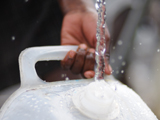Whose Water is It?
25 Feb 2009
By Verena Schaer, Denis Burke for ISN
Many states depend on shared water resources - a situation that leads to increasing inter-state competition for the life-sustaining liquid. Over 200 rivers are shared by two or more countries, and some 60 percent of global freshwater is contained in international drainage basins. Watercourses, then, are naturally interconnected so that their conservation and use do not solely depend on one country.
However, control over water resources at the interstate level can induce conflict over issues of territorial sovereignty. Originally, sovereignty was understood as a state's right to exploit its resources for advancement of its own environmental and developmental policies. But the notion of state sovereignty has evolved in recent decades. The idea that relations between a state and its citizens no longer fall exclusively under the jurisdiction of the state itself but are, in fact, the concern of the entire global community is now a widely embraced international norm. We are therefore witnessing a new paradigm whereby the theories of absolute territorial sovereignty and integrity appear to be eroding. Current water management schemes must contend with this evolving definition of the sovereign state.
Any discussion about water and territorial sovereignty must take into account the concept of virtual water, defined as the volume of water used in agricultural or industrial production. In fact, 90 percent of the freshwater consumed by people is virtual water.
Virtual water by its very nature necessitates inter-state dependencies. An estimated 16 percent of external pageglobal water usecall_madeis not for producing domestically consumed products but products for export. A considerable volume of water is embedded in water-intensive commodities such as grain. About 1,000 tons of water are required to produce a ton of wheat. When an economy imports a ton of wheat it is in effect importing external page1,000 tons of watercall_made. The Middle East and North Africa were importing annually about 40 million tons of grain and flour by the end of the 1990s. About 40 billion tons of water would be required to produce this volume of grain. Such an amount reflects about 20 percent of the region's annual water use and is equivalent to the water used each year by Egypt alone in its agricultural sector.
To capitalize on the interdependencies necessitated by virtual water, states in which water is a comparatively scarce resource could import products that require a lot of water in their production and export those that require less. This could relieve pressure on a water poor country's own water resources. In addition, some countries are better technologically prepared to produce certain goods using less water.
Ultimately, national water policies should account for virtual water flows. Many states' viability depends on its capacity to sustain trade in virtual water.
Case Study: Palestinian-Israeli Water ResourcesMore than half of Israel's water resources are collected outside its territorial boundaries. Israel depends on water from extra-territorial rivers and from the Occupied Territories. In fact, 60 percent of Israel's groundwater supply and 25 percent of its surface water supply originated in the Occupied Territories.
Israel has constructed an elaborate system of water transportation channels called the National Water Carrier. It provides water to communities along the coastal areas, including Tel Aviv and the arid southern zones, where most agricultural activities take place. Israel has deemed the amount of water transported by the carrier as a question of national security, so that information has not been made public.
Israel has also developed an efficient system to recycle water and has invested in advanced agricultural technologies. Only 30 percent of the water in that region comes from rivers with groundwater serving as the major water source. The most important groundwater sources are located in one of three aquifers, one of which is partially located below the Gaza Strip and has been exploited for many years. Overuse of the aquifers has caused seawater to invade the freshwater wells, making freshwater less potable.
The Israeli government controls water use through extraction permits, and Palestinians generally pay more for water than Israelis, while using far less. Palestinians receive fewer permits than Israeli citizens and are only allowed to extract water from surface wells that are mostly affected by droughts. This inequitable allocation of water combined with well-drilling by Israeli settlers have exacerbated high tensions in the region.

